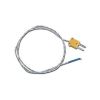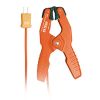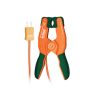Extech Metal Vane Thermo-Anemometer/Datalogger
Features
- Adjustable data sampling rate: 1 to 3600 seconds
- Record/recall min/max readings
- Built-in PC interface
- Free ground shipping
- Expedited repair and warranty service
- Lifetime technical support
- More
Overview
The Extech Metal Vane Thermo-Anemometer Datalogger data/time stamps and stores readings on an SD card in Excel format for easy transfer to a PC. The manual functions stores 99 readings. The metal vane withstands temperatures to 158°F (70°C) and air velocity to 6900ft/min.
Mechanics
The adjustable sampling rate is from 1 to 3600 seconds. The type K/J thermocouple input performs high-temperature measurements. The large LCD displays air velocity and temperature simultaneously, and the bearing vane wheel on 39" cable has a 2% velocity accuracy. The built-in PC interface allows for connectivity to further analyze data points. Additional meter functions include data hold, automatic power off, disable, and record/recall max/min readings.
- Air velocity m/s range: 0.4 to 35m/s
- Air velocity m/s resolution: 0.1m/s
- Air velocity m/s basic accuracy: ±2%rdg
- Air velocity ft/min range: 60 to 6900ft/min
- Air velocity ft/min resolution: 1ft/min
- Air velocity ft/min basic accuracy: ±2%rdg
- Air velocity MPH range: 0.7 to 78.2MPH
- Air velocity MPH resolution: 0.1MPH
- Air velocity MPH basic accuracy: ±2%rdg
- Air velocity knots range: 0.6 to 68knots
- Air velocity knots resolution: 0.1knots
- Air velocity knots basic accuracy: ±2%rdg
- Air velocity km/h range: 1.0 to 126.0km/h
- Air velocity km/h resolution: 0.1km/h
- Air velocity km/h basic accuracy: ±2%rdg
- Temperature range: 32 to 158°F (0 to 70°C)
- Temperature resolution: 0.1°
- Temperature basic accuracy: ±1.5ºF/0.8ºC (<60°C)
- Type K temperature range: -148 to 2372°F (-100 to 1300°C)
- Type K temperature resolution: 0.1°
- Type K temperature basic accuracy: ±(0.4% + 1.8°F/1°C)
- Type J temperature range: -148 to 2192°F (-100 to 1200°C)
- Type J temperature resolution: 0.1°
- Type J tempreature basic accuracy: ±(0.4% + 1.8°F/1°C)
- Memory: 20M data records using 2G SD card
- Dimensions: 7.2 x 2.9 x 1.9" (182 x 73 x 47.5mm)
- Weight: 17.2oz (487g)
- (1) Meter
- (1) Metal vane sensor with 3.9ft (120cm) cable
- (1) 2GB SD card
- (6) AA batteries
- (1) Hard carrying case
In The News
Three Decades of Research at Acton Lake
A multi-disciplinary team at Miami University, Ohio, has been studying the environmental change at Acton Lake for over three decades. Using three different NexSens buoys over this time, the team has an incredible archive of data that is helping build a picture of Acton’s past, present, and future. Until recently, a NexSens CB-50 buoy was used alongside other environmental monitoring at Acton Lake. In May 2025, the Miami team deployed a new XB-200 buoy , future-proofing their ongoing monitoring using real-time buoy systems. Acton Lake, a small hypereutrophic reservoir in southwest Ohio, covers 2.4km² and has a maximum depth of about 8m. The dam was built in 1956, and the lake has a large agricultural watershed.
Read MoreSource Water Monitoring in Albany, New York: Tracing Water Quality throughout Tributaries
Thousands of US cities pull their drinking water from natural source waters like reservoirs, rivers, and streams, making overall watershed health a key consideration for water providers. In Albany, New York, the Albany Department of Water and Water Supply delivers drinking water to over 100,000 residents as well as monitors and manages the larger drinking water supply watershed. Hannah Doherty, Environmental Specialist at the Albany Department of Water and Water Supply , spends her days working with a small team to monitor the drinking supply and the connected water bodies. Doherty explains, “We’re the first to encounter the water that ends up being the drinking water.
Read MoreWildfire Prevention in the Sierra Nevada Region with the Yuba Watershed Institute
Though recent wildfires have sparked new conversations about wildfire management and response, groups like the Yuba Watershed Institute have been monitoring the forests and water resources of the Sierra Nevada region for decades, managing approximately 5,000 acres of land with the Bureau of Land Management (BLM) and about 7,000 acres in private land partnerships. The goal of the Institute is to work with local communities and land agencies to improve watershed and forestry management through informed practices and public outreach. The goals of the Yuba Watershed Institute are three-fold: Improve the ability of fire suppression agencies like the California Department of Forestry and Fire Protection ( CAL FIRE ) and the US Forest Service.
Read More












